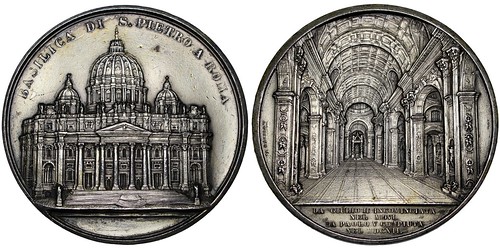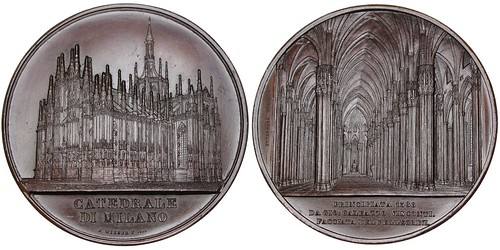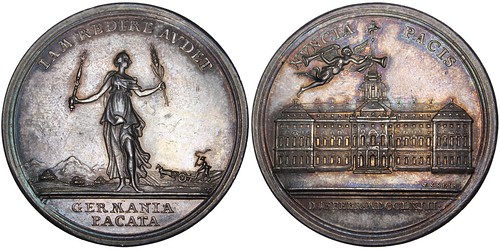
PREV ARTICLE
NEXT ARTICLE
FULL ISSUE
PREV FULL ISSUE
NUMISMAGRAM MEDAL SELECTIONS: MARCH 3, 2023Jeremy Bostwick at Numismagram forwarded these three highlights from his recent upload of new material to his website. As may be indicated by these selections, the upload focuses heavily upon architectural themes in exonumia—especially the popular cathedral series of Jacques Wiener and his brothers. For all of the new items, please visit https://www.numismagram.com/inventory. -Editor 102314 | ITALY. Vatican City. St. Peter's Basilica silvered bronze Medal. Issued 1857. Most Remarkable Edifices of Europe series (60mm, 94.93 g, 12h). By J. Wiener in Brussels and struck at the Geerts mint in Ixelles. BASILICA DI S. PIETRO A ROMA, perspective view of the eastern façade of the exterior of the Basilica, from a viewpoint just to the left of center / Perspective view of the interior looking down the nave toward the baldacchino; in four lines in exergue, DA GIULIO II INCOMINCIATA / NEL MDVI / DA PAOLO V COMPIUTA / NEL MDCXII. Edge: Some scattered light marks, otherwise plain. Cf. Ross M201 (R1; for bronze/silver); cf. von Hoydonck 152 (same); cf. Reinecke 50 (same). About Uncirculated. Mostly argent-gray surfaces, with a slight matte nature and darker hues nearer the peripheries. Compare to a similar example in Stack's Bowers NYINC 2022 auction, lot 7550 (which sold for a total of $1,200). $465. Michael Ross, noted author of Jacques Wiener's Most Remarkable Edifices of Europe: The Man, Monuments, and Medals, has found no evidence for medals in this series being issued in silvered bronze, only in separate silver and bronze strikings. Given the disparity in price between silver and bronze examples during their time of production, he believes it likely that an enterprising individual or two took bronze examples and silvered them privately, passing them off as the next best thing to the silver specimens. No matter their post-mint silvering, these silvered examples continue to be collected along with their bronze and silver brethren. Located in what is now the Vatican City—the Papal enclave situated entirely within Rome—St. Peter's Basilica was planned by then-Popes Nicholaus V and Julius II to replace the old St. Peter's Basilica. Begun in 1506 and completed in 1626, it is the largest church in the world, with respect to its interior, and is the most renowned structure of Renaissance architecture. An iconic site for pilgrimages, its famous dome still features rather prominently in any skyline of Rome. From what is today eastern Netherlands and western Germany, the Wieners were a Jewish family of exceptional medalists, especially known for numerous numismatic works throughout the Kingdom of Belgium. Eldest brother Jacob (Jacques), along with younger brothers Leopold and Charles, created some of the finest works of medallic art of the 19th century, and all are particularly noted for their work in the highly detailed and intricate work of architectural renderings.
To read the complete lot description, see:
102282 | ITALY. Milan. Milan Cathedral (Duomo) bronze Medal. Issued 1860. Most Remarkable Edifices of Europe series (59mm, 89.00 g, 12h). By J. Wiener in Brussels and struck at the Geerts mint in Ixelles. Exterior view of the cathedral from the southwest; CATEDRALE / DI MILANO / Interior view down the nave, looking toward the altar, and encompassing the side aisles to the north and south as well; PRINCIPIATA 1386 / DA GIO: GALEAZZO VISCONTI / FACCIATA DEL PELLEGRINI. Edge: Plain. Ross M229 (R1); van Hoydonck 177; Reinecke 47. Choice Mint State. Deep brown surfaces, with some delightful brilliance radiating from the fields. Compare to a similar example in Stack's Bowers February 2023 CCO, lot 71272 (which sold for a total of $600). $495.
To read the complete lot description, see:
102133 | UNITED STATES & GERMANY. Colonial America and Preußen (Prussia) silver Medal. Issued 1763. The Treaty of Hubertusburg and the end of the Seven Years' War (French and Indian War in America) (44mm, 21.95 g, 12h). By J. L. Oexlein. IAM REDIRE AVDET (now she dares to return...), Germania standing facing, head right, holding scepter and grain ear; mountains and plowman in background; in two lines in exergue, GERMANIA / PACATA (...with Germany being at peace) / NVNCIA PACIS (the messenger of Peace), view of the Hubertusburg Palace; above, Fama (Rumor) flying right, blowing in one trumpet and holding another; D 15 FEBR MDCCLXIII in exergue. Edge: Plain. Betts 446; Pax in Nummis 595; Olding 931; Henckel 1658. PCGS MS-62. Pleasantly toned and alluring, with some cobalt, magenta, and goldenrod sprinkled throughout, along with some enchanting brilliance. Tied with just one other example for the top spot in the PCGS census. $495. Sometimes referred to as 'World War Zero,' given its scale overall number of belligerent powers, the Seven Years' War began primarily with Austria's desire to recover Silesia from the Kingdom of Prussia. Since Great Britain had been aiming to increase her colonial possessions in the New World at the expense of France, the strife in the American theater began to merge with that in Europe, resulting in a legitimate global conflict, with every major European power taking the side of either Great Britain/Prussia or France/Austria. In addition to North America and Europe, skirmishes also played out in Central America, the western coast of Africa, India, and the Philippines. Ultimately, a peace was achieved through the Treaty of Paris, formally ending all conflicts save for the Silesian question; the Treaty of Hubertusburg, signed five days later, ended the issue between Prussia and Austria, formally ending the war. Hubertusburg Palace was begun in 1721 at the behest of August II ‘the Strong,' the Elector of Sachsen (Saxony) and King of Poland, and completed just three years later in 1724. The naming for the new palace emanated from the fact that August commissioned its construction on 3 November during the feast of St. Hubertus. What was originally a baroque castle—one of the largest in Europe at the time—was rebuilt in the decades following August's death by his son and successor, August III—this time in rococo fashion. Used a great deal as a hunting lodge, the palace was left virtually unoccupied at the outbreak of the Seven Years' War in 1756. Upon the conclusion of the war in that theater, a peace treaty was ratified there, though furniture from nearby venues needed to be retrieved in order to furnish the mostly empty palace, as it had been wholly plundered during the war. Shortly thereafter, its use as a leisure residence was over, as it served as a military hospital during the Napoleonic Wars and a penitentiary during the second half of the 19th century.
To read the complete lot description, see:
Wayne Homren, Editor The Numismatic Bibliomania Society is a non-profit organization promoting numismatic literature. See our web site at coinbooks.org. To submit items for publication in The E-Sylum, write to the Editor at this address: whomren@gmail.com To subscribe go to: https://my.binhost.com/lists/listinfo/esylum All Rights Reserved. NBS Home Page Contact the NBS webmaster 
|



